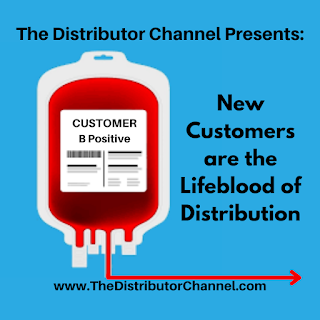New Customers: The Lifeblood of Distribution
Having a solid source of new customers is important. Yet, according to our 2022 State of Distributor Sales research, only a dismal 34 percent of distributors are happy with the number of new customers brought into their organization each year.
The distributors we spoke with went on to state that
traditional salespeople were their primary source of new customers. It has been my experience, and this research
further illustrates, that distributor salespeople do a poor job of
prospecting. This statement is not meant
to degrade the work of sellers.
Today’s salespeople are generally too busy to devote the
time required to find new customers.
Even if they are trained in the process, carrying out the work does not
pay great dividends. Throw in the point
that it is easier to sell more to existing customers than to go out and find
new customers and the case for a better way to find customers becomes more
solid.
Leads for new customers are important
Leads that identify new potential customers (and new
contacts at existing accounts) are universally recognized as a solid source of
new customers. Distributors are
interested in receiving these leads from their supply partners. What’s more, the distributors we spoke to
indicate leads from suppliers tend to be the best quality (versus leads
purchased or generated in-house).
One of the reasons for this higher quality comes by way
of the process most supply partners go through before sending the leads out to
the distributor. Typically,
manufacturers put their leads through a screening process that looks a bit like
this:
1.
Lead is generated via trade publication, online
offering, or tradeshow.
2.
Lead is checked to determine if it came from a
real person or real company.
3.
Lead is contacted by phone or email to determine
if the customer is simply gathering information for the future or has an
immediate need.
4.
Lead is provided with additional technical or
delivery data.
5.
If the lead is immediate or has well-defined
future needs, the lead is passed to the distributor.
This process costs money. First, just identifying and acquiring the raw lead may run in the 50–100-dollar range. The cost of
qualifying the lead adds to the cost – pushing it well over $100. Regardless of the exact number, these things cost money. Second, most supplier marketing teams are measured on their ability to provide quality leads. The best companies try to tie lead costs to opportunities created.Why does this matter?
Manufacturers, our supply partners, have a choice as to
where they send their leads. The leads
are already expensive and the cost of acquiring the leads continues to
increase. To justify the leads, they
need to know three important points:
1.
Are the leads followed up promptly by a
qualified distributor salesperson?
2.
Do the leads result in opportunities? They understand they will not be able to
capture every opportunity, but does the customer at least have the potential to
purchase their equipment?
3.
What orders are harvested because of the lead?
Sadly, only a few of the more progressive distributors track
leads like this in a disciplined manner.
Instead, most rely on anecdotal feedback from their sales teams. Moving from sad to terrible, evidence
indicates some salespeople just never quite get around to following up on
leads.
Looking into the future of leads
Distributors report that leads from e-Commerce efforts is
the fastest growing category. That’s the
good news. The bad news is the leads being
channeled to the sales team are of poor quality. Why? There
is no filtering of the leads before being handed off to already busy
salespeople.
Extending even further, distributors are upping the ante
on their marketing efforts. These groups
are bringing in even more leads using Linkedin targeted ads, social media,
Google Ads, and other tools. Again,
mostly unqualified.
The best distributors of the future will soon be
measuring their websites and marketing efforts against the lead process. The efforts will be expensive and there will
be a need to “justify” the cash outlay.
The same kind of process needs to be developed for
internal leads as with those sent from manufacturers.
Finally,
Our 2022 State of Distributor Sales Report discusses lead information and other valuable metrics. It can be downloaded for free here.
28 years of "in the trenches" training and 17 years as a consultant. He serves as a personal coach to industry leaders across many lines of distribution. He has authored 5.5 books (one is almost done) and has written hundreds of articles for national trade magazines.








Comments